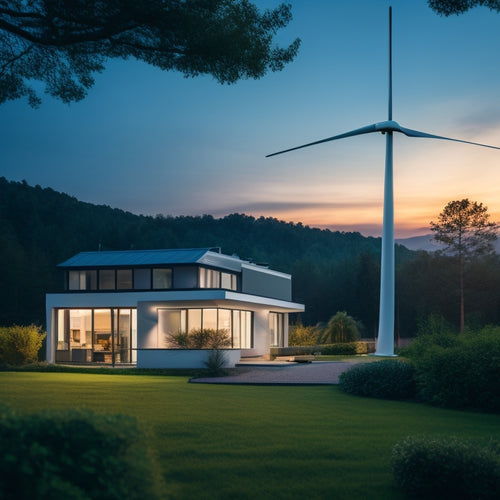5 Tips for Electric Vehicle Charging With Sunshine
Share
You're taking your eco-friendly habits to the next level by harnessing solar power to charge your electric vehicle. To get started, install solar panels to generate electricity and reduce your reliance on the grid. Position them for maximum sunlight exposure to optimize energy output and charge your EV during peak hours for the best results. Make sure you install them correctly, considering the best angle and direction for maximum sunlight capture. By doing so, you'll take control of your energy expenses and gain a better understanding of your energy usage. Now, take the next step to realize the full potential of solar-powered EV charging.
Key Takeaways
• Install solar panels at an optimal angle and direction to maximize energy output for faster EV charging.
• Charge your EV during peak sunlight hours for the fastest charging times and most efficient energy use.
• Consider net metering policies to sell excess energy back to the grid and offset your energy expenses.
• Monitor and maintain your solar panel system regularly to ensure optimal performance and energy production.
• Store excess solar energy in a battery for nighttime charging, reducing your reliance on the grid and energy waste.
Harnessing Solar Power for EVs
As you consider powering your electric vehicle with renewable energy, one innovative approach is to harness solar power, a clean and abundant resource that can greatly reduce your carbon footprint.
By installing solar panels, you can generate electricity and charge your EV simultaneously, reducing your reliance on the grid. With Grid Parity, the cost of solar energy has become competitive with traditional fossil fuels, making it an attractive option.
Additionally, Net Metering policies allow you to sell excess energy back to the grid, offsetting your energy costs. By integrating solar power into your EV charging routine, you'll not only reduce your environmental impact but also gain more control over your energy expenses.
Maximizing Charging Speed With Sunlight
By strategically positioning your solar panels to maximize sunlight exposure, you can optimize the energy output and expedite the charging process of your electric vehicle.
To maximize charging speed, harnessing sunlight during peak hours when the sun is highest in the sky is crucial. This typically occurs between 9 am and 3 pm, depending on your location and time of year.
Be mindful of cloud cover, as it can greatly reduce energy output. By charging during peak hours and minimizing cloud cover, you can maximize your solar panel's energy output, resulting in faster charging times for your electric vehicle.
With careful planning, you can take control of your EV's charging process and make the most of the sun's energy.
Installing Solar Panels Correctly Matters
You'll need to make sure your solar panels are installed at a perfect angle and direction to capture the most sunlight, as even slight miscalculations can greatly impact energy production. Consider your roof's orientation and adjust the panel's tilt to maximize energy output.
A south-facing roof with minimal shading is ideal, but don't worry if that's not possible – you can still optimize energy production with careful planning.
Regular panel cleaning is also essential, as dirt and debris can reduce energy output by up to 25%. Clean your panels every 6-12 months to maintain peak performance.
Optimizing Energy Storage for EVs
With your solar panels generating clean energy, now it's time to think about optimizing energy storage for your EV, which requires a deep understanding of your daily driving habits and charging patterns.
To maximize your energy independence, you'll want to take into account the following factors:
-
Battery Health: Monitor your battery's state of charge to make sure it's not overcharged or undercharged, which can affect its lifespan.
-
Grid Resiliency: Store excess energy generated by your solar panels during the day to use during nighttime charging or power outages.
-
Smart Charging: Adjust your charging schedule to align with your energy generation patterns, reducing strain on the grid and optimizing your energy storage.
Monitoring and Maintaining Your System
Your energy independence relies on a well-maintained system, so it's important to regularly inspect and fine-tune your setup to guarantee peak performance and identify potential issues before they escalate.
To guarantee your system runs smoothly, perform regular energy audits to pinpoint areas for improvement. This may lead to system upgrades, which can boost efficiency and reduce energy waste.
| Task | Frequency |
|---|---|
| Inspect connections and cables | Monthly |
| Check inverter performance | Quarterly |
| Conduct energy audits | Bi-annually |
Frequently Asked Questions
Can I Charge My EV Directly From the Solar Panels?
You can charge your EV directly from solar panels, but you'll need a DC Converter to match the panel's voltage and current; consider panel efficiency, too, to guarantee maximum energy harvesting.
Are Solar Panels Compatible With All Electric Vehicle Brands?
As you navigate the EV market, you'll find that solar panels are compatible with most electric vehicle brands, thanks to standardized Vehicle Integration and Brand Standards, ensuring seamless charging, regardless of panel efficiency.
Do I Need a Backup Generator for Cloudy or Rainy Days?
When considering power reliability, you'll want to evaluate energy storage options, like batteries, to mitigate cloudy or rainy days, ensuring a consistent charge for your EV, and deciding if a backup generator is necessary for your needs.
Can I Sell Excess Energy Back to the Grid?
"Will you profit from your eco-friendly investment? Yes, you can sell excess energy back to the grid through Net Metering, providing Grid Services, and earning credits, giving you control over your energy consumption and costs."
Are There Any Government Incentives for Solar EV Charging Systems?
You'll find government incentives for solar EV charging systems, such as federal Tax Credits and state-specific Rebate Programs, which can greatly reduce your upfront costs, putting you in control of your clean energy investment.
Related Posts
-

Why Biodegradable Dish Soap Matters for Earth-Conscious Homes
You likely don't realize that the dish soap you're using today will still be harming the environment long after you'v...
-

10 Grid-Tied Wind Power Systems for Modern Homes
You're looking for a grid-tied wind power system to utilize wind energy for your modern home. Here are ten options to...
-

7 Smart Air Purification Hacks for Energy-Savvy Homes
You can notably improve your indoor air quality while minimizing energy consumption by implementing strategic air pur...


